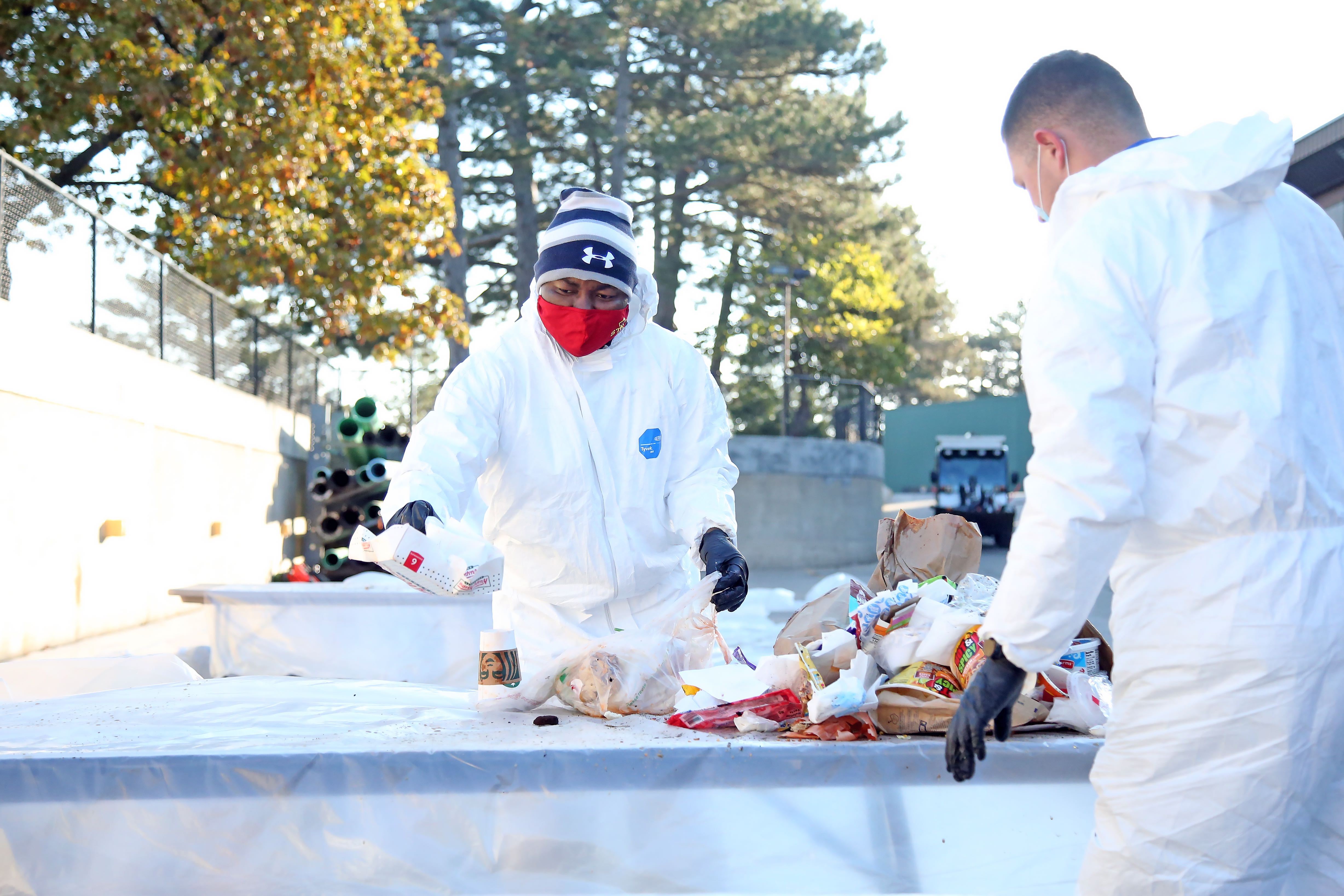FY20 gave first full picture of campus waste production
Author: Dave Roepke
This is an archived story. The content, links and information may have changed since the publication date.
Author: Dave Roepke

Recycling and special events coordinator Ayodeji Oluwalana sorts through trash collected in Frederiksen Court apartments during an Oct. 30 trash audit. Oluwalana and student volunteers conducted the audit to assess the impact of a food waste composting program in Frederiksen Court. Photo by Blake Lanser.
It is impossible to know how much progress Iowa State is making on its zero-waste goal to reduce landfill usage by 85% by 2025 if it isn't clear how much waste it produces in the first place.
Which makes 2020 a landmark year for recycling and special events coordinator Ayodeji Oluwalana, who oversees the university's zero-waste initiative. Due to the variety of ISU hauling contracts, fiscal year 2020 was the first time he was able to accurately determine how much waste the university generated and what happened to it -- including at athletics venues and research farms. The FY20 data will serve as the benchmark for measuring future improvements.
That's the good news. The bad news, though unsurprising? It's a pretty big number. In the fiscal year ending June 30, Iowa State produced more than 11,000 tons of solid waste, and more than one-quarter of it ended up in the landfill near Boone that serves the Ames area.
"We're sending over 3,000 tons to the landfill annually. That's a huge amount," Oluwalana said.
|
Destination |
Weight (tons) |
Proportion of total waste |
|
Reused/donated |
92 |
0.8% |
|
Recycled |
5,255 |
46.3% |
|
Composted |
385 |
3.4% |
|
Refuse derived fuel (Ames power plant) |
2,515 |
22.2% |
|
Landfill |
3,102 |
27.3% |
|
Total |
11,349 |
|
In fiscal year 2019 -- using approximations that didn't consider major aspects such as the athletics department and debris from construction and demolition -- Oluwalana estimated a diversion rate of about 67%. Keeping 73% of waste out of the landfill in FY20 probably represents some progress.
But without the city of Ames' Resource Recovery Plant, a waste-to-energy facility that uses burnable garbage for power plant fuel and sends the rest on to the landfill, the rate would be worse. About half of waste produced on campus was hauled away as trash, though more than 2,500 tons were burned at the recovery plant. Using trash as fuel is better than dumping it in the landfill, but it's on the lowest tier of the U.S. Environmental Protection Agency's waste management hierarchy, which prefers reuse and reduction above all.
"Ultimately, the goal isn't to manage waste but eliminate it," Oluwalana said. "If we can control what we generate, we don't have to focus on recycling."
To celebrate America Recycles Day, a virtual Q&A will be held Nov. 13 (1-2:15 p.m.). ISU employees and students involved in sustainability work will discuss the state of campus recycling efforts.
Of the more than 5,200 tons recycled in FY20, plastic, paper and metal collected in single-stream bins and the separate cardboard recycling program together accounted for only about 7%. About 86% was recycled construction and demolition materials.
In addition to setting a baseline for future years, accurate statistics are helpful as Oluwalana seeks to partner with departments and units on waste reduction. It allows analysis based on budget savings, an effective attention-getter. Recycling, reusing and composting materials saved the university about $544,300 in landfill disposal fees in FY20, for instance.
"People react to data," he said. "When they understand the financial implications, I think they're more likely to buy in."
President Wendy Wintersteen's approval of a five-year sustainability plan also will help drive interest in waste-reduction efforts, Oluwalana said.
Departments and units can request a presentation on waste reduction by emailing recycling@iastate.edu.
Cleaning and safety protocols necessary during the pandemic tend to increase trash, but in the first quarter of FY21, July through September, overall ISU garbage production is down. However, Oluwalana said, waste hasn't decreased as sharply as campus density.
"With less people, we shouldn't be generating this amount," he said.
In July 2019, ISU produced 193 tons of trash either burned at the Ames power plant or shipped to the landfill, compared to 173 tons in 2020. In August 2019, 214 tons were hauled away as trash, compared to 207 in 2020. With the return of students in September, the difference was more noticeable, with 324 tons in 2019 and 243 in 2020.
Earlier this fall, Oluwalana shared some ideas on how to limit waste production during the pandemic.
Custodial service changes caused by the pandemic have paused some of the initiatives Oluwalana hopes to expand to boost recycling rates on campus, including a plan to make recycling bins the only option for at-desk disposal bins in office spaces.
One new program that launched in the past year is a composting service for food waste in the Frederiksen Court apartments. Organized by the Engineers for a Sustainable World student club, the program began last fall after a six-week pilot in spring 2019. Oluwalana said he's working with students to expand the composting option to other university apartments and to make sure the push for composting continues even after the students involved graduate.
"We've started talking about a succession plan," he said.